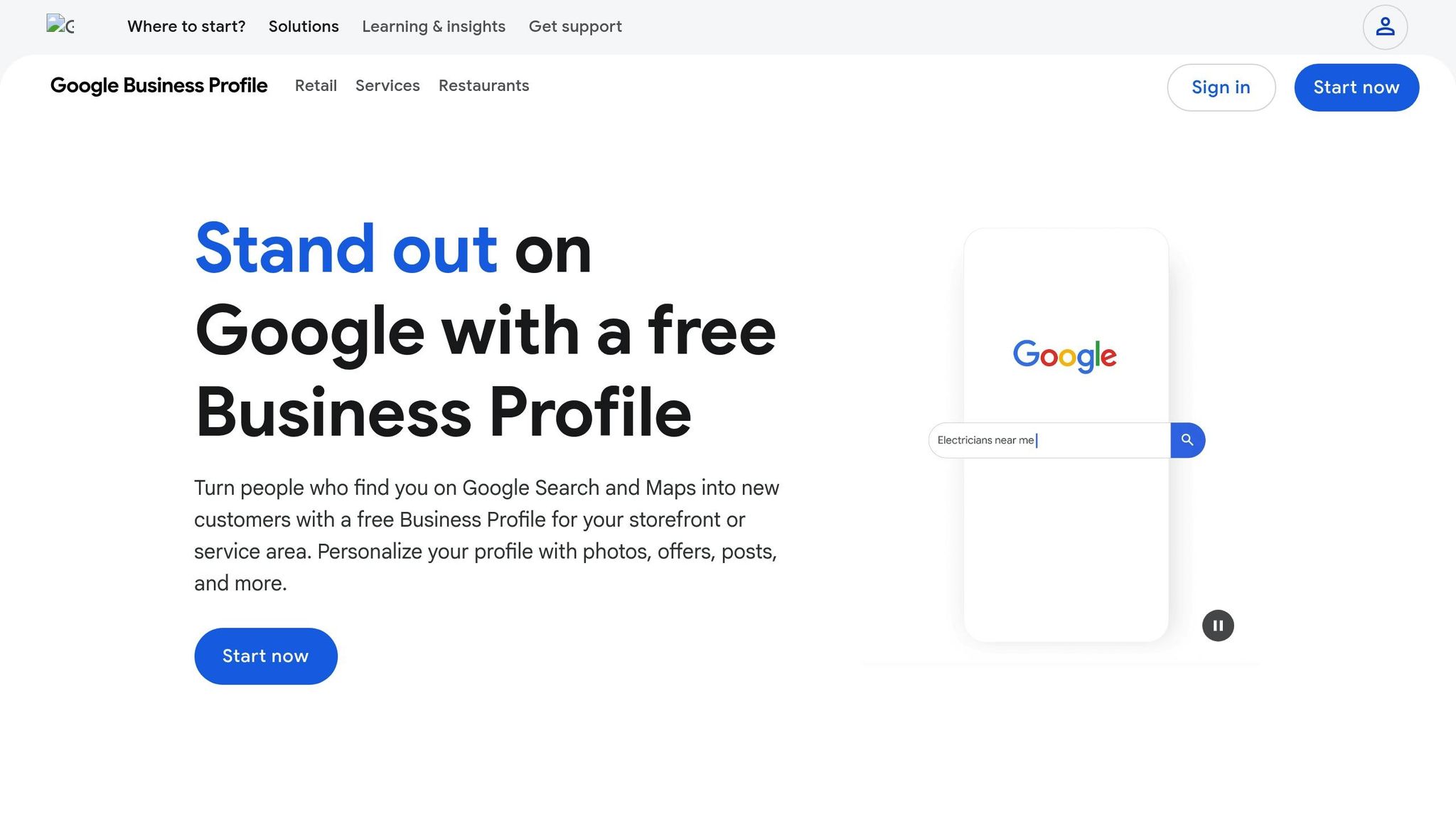When search behavior shifts with the seasons, businesses can use seasonal keywords to attract more local customers. These keywords, tied to holidays, weather changes, or events, can significantly boost visibility and sales during peak times. For example, searches for "pumpkin pie delivery" might jump 300% before Thanksgiving, offering bakeries a clear opportunity.
Key Takeaways:
- Seasonal keywords see spikes in popularity during specific times of the year (e.g., "Christmas tree farm near me").
- They reflect high purchase intent, making them ideal for driving local traffic and conversions.
- Even non-seasonal businesses can benefit by targeting specific seasonal needs (e.g., snow shovels before a storm).
How to Leverage Seasonal Keywords:
- Use tools like Google Trends or Keyword Planner to identify trends.
- Pair keywords with location-specific terms (e.g., "holiday catering in Dallas").
- Plan content weeks in advance to align with search demand.
- Update your Google Business Profile with seasonal offers and photos.
- Track performance metrics like keyword rankings, website traffic, and local engagement.
What Are Seasonal Keywords and How They Work
Definition of Seasonal Keywords
Seasonal keywords are search terms that see a surge in popularity during specific times of the year - often tied to seasons, holidays, events, or weather changes. Unlike general keywords that maintain steady interest throughout the year, these keywords follow predictable patterns of demand based on timing.
Seasonal keywords typically fall into two main categories: time-based keywords (like "spring tune-ups" or "winter warm-ups") and event-based keywords (such as "Black Friday deals" or "Christmas gift ideas"). They reflect current consumer interests, making them especially valuable for local businesses that align their offerings with these trends. Understanding how seasonal changes affect local search behaviors can help businesses capitalize on these opportunities.
How Seasons Change Local Search Patterns
Customer needs and priorities naturally shift with the seasons, creating distinct opportunities for businesses. For example, spring often brings a focus on fresh starts and home improvement, while summer is tied to outdoor activities and vacation planning. Fall emphasizes back-to-school shopping and pre-winter preparations, and the winter season highlights gift-giving and year-end sales.
These seasonal shifts directly influence search behaviors. Take a local bakery, for instance - it might see consistent interest in "birthday cakes" year-round, but searches for "pumpkin pie delivery" could spike during Thanksgiving week. Similarly, HVAC companies might notice that searches for "furnace installation in [City]" or "emergency heating services" dominate during colder months, while interest shifts to air conditioning services as the weather heats up.
Unexpected weather events can also drive short-term spikes in search demand. A sudden heat wave might lead to a surge in "AC repair" searches, while an approaching winter storm could prompt increased interest in "snow removal services".
Finding Your Business's Peak Seasons
Recognizing these seasonal patterns is key to identifying your business's peak demand periods. Start by analyzing historical data to uncover when demand for your products or services tends to spike. Reviewing past sales and customer inquiries can reveal recurring trends.
Next, consider customer behavior to understand why and when people turn to your business. For instance, a carpet cleaning service might find demand peaks during spring (March–May) as part of seasonal cleaning routines and again in the pre-holiday months (November–December).
Google Trends is a great tool for tracking keyword popularity over time. It can show exactly when specific terms begin to gain traction, helping you align your marketing efforts. Monitoring conversion rates during these periods can also provide insights into user intent. Don’t forget to factor in regional variations - keywords that perform well in one area might not be as relevant elsewhere. For example, a ski resort in Colorado will experience different seasonal trends than a beach rental business in Florida.
Once you’ve identified your peak seasons, you can optimize your website and Google Business Profile to make the most of these opportunities and boost your local SEO performance.
Colder Weather Means Focus on Your Heating Keywords - #localseostrategy
How to Find and Choose Seasonal Keywords
To make the most of seasonal search patterns, selecting the right keywords is crucial. This requires a thoughtful mix of data analysis and understanding local market trends. The goal? Pinpoint the terms your customers are searching for during specific seasons and identify when interest in those terms peaks.
Best Tools for Finding Seasonal Keywords
A great starting point is Google Trends, a free tool that highlights when interest in specific keywords surges throughout the year. For instance, a quick search for "pumpkin spice" will show its predictable spike every October. You can also refine the data by geographic location to see how trends differ in your target areas.
To complement this, Google Keyword Planner provides search volume data. While Google Trends helps you understand when interest in a keyword is high, Keyword Planner reveals how many people are searching for terms like "Thanksgiving events in Texas" during those peak times.
For more detailed insights, platforms like SEMrush, Ahrefs, and AI-driven local SEO tools can help you uncover micro-trends and seasonal demand down to the neighborhood level. These tools are particularly useful for identifying niche opportunities and staying ahead of competitors.
A smart approach combines these tools: start with Google Trends to spot seasonal patterns, use Keyword Planner to confirm search volume, and leverage advanced platforms for competitive analysis and forecasting.
Adding Location Words to Seasonal Keywords
Pairing seasonal keywords with location-specific terms can significantly improve your local search visibility. For example, instead of targeting a broad term like "spring cleaning", aim for something more specific, such as "spring cleaning services near downtown Austin". This not only narrows your focus but also ensures you’re reaching people actively searching for services in your area.
Local search behavior often includes geographic markers. Many users add their city, neighborhood, or phrases like "near me" to their search queries. For instance, a flower shop optimizing for "Mother's Day bouquets in Chicago" is more likely to attract local customers.
Consider the unique traits of your region or local events to create targeted opportunities. A business in New England might focus on "fall foliage tours", while one in Florida could target "hurricane preparation services." These tailored keywords help connect you with the specific needs of your community.
Planning Your Seasonal Content Schedule
Once you’ve identified the best seasonal keywords, it’s time to plan your content to align with rising search demand. A well-organized seasonal content calendar ensures you’re publishing ahead of peak interest periods. Seasonal searches often gain traction weeks before a holiday or event, so timing is everything.
Your calendar should include key dates like holidays, local events, weather changes, and industry-specific busy times. For example, an HVAC company might publish content about air conditioning maintenance before summer heatwaves hit. Similarly, a landscaping business could release spring preparation tips as early as February.
Make it a habit to review and update your calendar annually. Trends evolve, and what worked last year might need tweaking based on new events or shifting consumer behavior. Staying flexible ensures you’re ready to capture fresh opportunities as they arise.
To keep your content strategy diverse, consider mixing formats. Service pages can provide stable, evergreen seasonal offerings, while blog posts can tackle trending topics. Social media updates and Google Business Profile enhancements should tie into your seasonal strategy, creating a cohesive message across platforms.
Tools like Local SEO Bot can simplify this process by automating updates to your Google Business Profile and tracking the performance of seasonal keywords. Automation allows you to focus on creating high-quality content while ensuring your local listings stay aligned with current trends.
The key to a successful seasonal keyword strategy lies in thorough research, precise targeting, and consistent execution. By using the right tools, focusing on local search intent, and planning your content schedule carefully, you’ll be in a strong position to attract customers when they’re actively searching for your services.
sbb-itb-0e6533f
How to Add Seasonal Keywords to Your Website and Listings
Seasonal search trends can significantly boost your visibility if you integrate the right keywords into your website and listings. This involves updating existing content, creating pages tailored to seasonal interests, and fine-tuning your Google Business Profile to align with seasonal demand. By doing so, you can position your business to capture the surge in local searches during peak seasons.
Updating Website Pages with Seasonal Keywords
To start, update your existing website pages by weaving seasonal keywords naturally into titles, headers, meta descriptions, and body text. For example, a cleaning service could use terms like "spring cleaning services in Chicago", while a furniture store might highlight "summer patio furniture deals in Miami".
Don’t overlook your images. Update image file names, alt text, and captions to include seasonal keywords. This helps search engines better understand your visual content and improves your chances of ranking.
For a bigger impact, create dedicated seasonal landing pages. Instead of altering your evergreen content, build new pages with URLs like "/fall-2025-activities-asheville" or "/winter-holiday-specials-seattle." This way, you can target seasonal searches directly. For example, a bakery might launch a page titled "Thanksgiving Pumpkin Pie Delivery in Dallas", linking it to their homepage to attract seasonal traffic while maintaining their standard service offerings.
Also, connect these seasonal pages to your main service pages. This not only strengthens your website’s internal linking but also helps search engines see the connection between your seasonal content and core services.
Lastly, update your structured data markup to highlight seasonal offerings. This makes it easier for search engines to showcase your business in local search results, potentially earning you rich snippets during high-demand periods.
Using Seasonal Keywords in Your Google Business Profile

Your Google Business Profile is a powerful tool for seasonal SEO. Small updates can make a big difference in visibility. Start by revising your business description to include seasonal keywords and, if applicable, update your primary category to reflect seasonal services. For instance, a restaurant might emphasize "Mother's Day brunch specials in San Diego", while a spa could highlight "holiday gift certificates in New York".
Posting seasonal updates is another effective tactic. Share posts tied to local events or holidays, such as "Join us for the Fourth of July fireworks in Chicago" or "Celebrate Mardi Gras with our special offers in New Orleans." These updates not only improve your local search visibility but also demonstrate your community involvement.
Keep your profile visually current by uploading seasonal photos and videos. A landscaping company might post images of spring garden makeovers in March or fall cleanup projects in October. This not only engages visitors but also signals to Google that your business is active and up-to-date.
Tools like Local SEO Bot can simplify this process by automating updates to your Google Business Profile. With features that allow one-click updates, you can easily keep your seasonal keywords and posts fresh.
Adjusting Content for Your Local Area
Tailoring seasonal content to your region’s specific characteristics is essential. Climate differences play a big role in timing. For instance, a landscaping business in Florida might start promoting "spring lawn care" in February, while in Minnesota, the same service might be relevant in late April.
Incorporate local events, holidays, and traditions into your seasonal updates to make your content more relatable. A business in New Orleans could focus on Mardi Gras, while one in Denver might highlight ski season preparations. This localized approach can improve your chances of appearing in location-specific searches.
Be prepared for unexpected weather patterns that can create sudden demand. For example, HVAC companies often see a spike in "AC repair" searches during heatwaves, while snow removal services might need to adjust their content during unexpected snowstorms.
Using local landmarks and traditions in your content adds authenticity. Instead of generic holiday promotions, reference specific destinations or traditions that resonate with your community. This not only connects with your audience but also boosts your local search relevance.
Timing is everything. Update your seasonal content 6-8 weeks before the peak season to give search engines time to index it. For summer promotions, aim for April or May, and for holiday content, start in late October or early November.
Tracking and Improving Your Seasonal SEO Results
Once you've sprinkled seasonal keywords across your website and listings, the next step is where the magic happens: tracking the results and using those insights to fine-tune future campaigns. Having a clear picture of what's working (and what isn't) can help you maximize your investment and refine your strategy for the next season. Let’s dive into the key metrics and strategies to keep your seasonal SEO on point.
Important Metrics to Track
Keep an eye on seasonal keyword rankings, spikes in organic traffic, conversion rates, and local engagement metrics. Pay attention to how your rankings shift for seasonal terms compared to your evergreen keywords, and measure the percentage increase in website visits during peak seasons versus quieter times.
Traffic patterns can tell you a lot. Look at which seasonal landing pages are driving the most visitors and attracting high-quality leads. If you’re targeting local customers, don’t forget to track Google Business Profile metrics like views, calls, and direction requests - these are strong indicators of local search visibility.
Conversion tracking is essential for understanding which seasonal keywords are bringing in customers who are ready to buy. For example, if "emergency heating services in Denver" has an 8% conversion rate compared to "HVAC maintenance in Denver" at 3%, you know where to focus your energy (and budget) during the winter months.
Local businesses should also monitor Google Business Profile interactions during seasonal campaigns. For instance, a restaurant promoting "Valentine's Day dinner specials in Austin" should see a surge in reservation calls and direction requests as February 14th approaches.
Using Data to Improve Future Seasons
Regularly review your seasonal performance data to spot trends and figure out what resonates with your audience. Create a scorecard that tracks each seasonal keyword’s ranking, traffic volume, and conversion rate to identify your top performers.
Within 2-4 weeks after the season ends, analyze your results. Document the highlights - like which keywords performed best, which content converted the most, and which landing pages drove the most traffic. Also, take note of what didn’t work, such as underperforming keywords, content gaps, or technical issues.
Evaluate which content types delivered the best results. Did your seasonal landing pages outperform blog posts? Did gift guides bring in more conversions than service pages? For example, if a cleaning service finds that "holiday deep cleaning" brought in 40% more leads than "cleaning for guests", they should focus on similar transactional keywords in future holiday campaigns.
Use tools like Google Trends to compare seasonal keyword performance year-over-year. This can help you pinpoint keywords that consistently perform well during specific months. If you’re targeting a local audience, don’t forget to analyze regional trends - some seasonal keywords may be more popular in your area than others.
To stay organized, build a "seasonal playbook" for each season. Include your top-performing keywords, the best content formats, the ideal publishing timeline, and any successful promotions. Update this playbook each year with new insights, adjusting your keyword targets, content ideas, and schedules.
Regular Seasonal SEO Check-ups
Make it a habit to audit your seasonal SEO strategy at least quarterly, with a deeper review at the start of each major seasonal period. Start by ensuring all planned seasonal content has been published and optimized.
Check that your seasonal landing pages are still ranking well for their target keywords, and update any outdated information, offers, or statistics. Tools like Local SEO Bot can simplify this process by automatically tracking ranking changes, monitoring Google Business Profile consistency, and flagging optimization opportunities. These tools can also generate reports comparing your current seasonal performance to previous years, making it easier to fine-tune your strategy.
During these check-ups, don’t forget to review title tags and meta descriptions to ensure they still include the right seasonal terms. Also, verify that internal links from evergreen pages to seasonal content are working correctly and that your seasonal pages remain properly indexed.
Schedule regular reviews during the off-season to keep refining your approach. For example, if you discover that publishing seasonal content six weeks before a holiday gives you better results than publishing two weeks before, adjust your timeline for next year.
Lastly, avoid common tracking errors, like comparing seasonal performance to the previous month instead of the same season last year. This can lead to inaccurate conclusions about your campaign’s success. Also, don’t overlook regional variations - optimizing for location-specific seasonal trends can give you an edge in your local market. By staying on top of these details, you’ll be well-equipped to keep your seasonal SEO strategy thriving year after year.
Conclusion: Using Seasonal Keywords to Grow Your Local Business
Seasonal keywords offer local businesses a chance to connect with high-intent customers when they’re actively searching for time-sensitive products or services. By focusing on key steps - like identifying peak seasons, researching locally relevant keywords, updating your website and Google Business Profile, and tracking performance - you can build a strategy that delivers consistent results year after year. Aligning your SEO efforts with seasonal trends can lead to noticeable growth.
The benefits are clear: greater visibility during high-demand periods, better conversion rates, and the ability to attract new customers looking for seasonal offerings in your area. For example, businesses can effectively connect with customers searching for timely services during their busiest times of the year.
To measure your success, keep an eye on metrics like organic traffic spikes, keyword rankings, conversion rates, and interactions on your Google Business Profile during peak seasons. Tools like Local SEO Bot can simplify this process by tracking ranking changes, ensuring your Google Business Profile stays consistent, and offering local SEO audits tailored to seasonal trends.
Sustained success, however, requires treating seasonal SEO as an ongoing effort. After each season, review your performance data to see which keywords and content delivered the best results, then refine your strategy. Creating a seasonal content calendar and updating keyword research annually can help you stay ahead of emerging trends.
Even businesses that don’t seem seasonal - like bakeries or hardware stores - can uncover opportunities by identifying spikes in demand for specific products or services throughout the year. With thoughtful planning and regular analysis, seasonal keywords can become a dependable way to grow your local business, connecting you with customers right when they need you most.
FAQs
How can businesses find and use the best seasonal keywords for their industry?
To find the best seasonal keywords for your business, start by diving into tools like Google Trends or keyword planners. These can help you pinpoint search terms that see a surge in popularity during certain times of the year and tie directly to what you offer. For instance, a bakery could focus on "Thanksgiving desserts" in November or "Valentine’s Day chocolates" in February.
Once you’ve nailed down the right keywords, weave them into your local SEO efforts. Update your Google Business Profile, refresh website content, and craft blog posts that highlight these seasonal terms. Don’t forget to align your promotions and ads with the seasonal buzz. By staying ahead of these trends, you can draw in more local customers and stand out during peak seasons.
How can I use seasonal keywords in my Google Business Profile to boost local SEO?
Seasonal keywords are a smart way to boost your local SEO, helping your business connect with timely trends and what customers are actively searching for. Here’s how you can weave them into your Google Business Profile (GBP):
- Revamp your business description: Add relevant seasonal terms like "holiday gifts" or "summer specials" to show you're tuned into the current season.
- Post seasonal updates: Use GBP posts to highlight promotions, events, or limited-time offers, making sure to include those seasonal keywords.
- Optimize product or service listings: Sprinkle seasonal phrases into your listings to increase their visibility when customers search for timely offerings.
By keeping your profile updated with seasonal touches, you'll make it easier for local customers to find exactly what they need - right when they need it.
How can businesses track the success of their seasonal SEO strategies and refine them for future campaigns?
To gauge how well your seasonal SEO strategies are working, dive into essential performance metrics like website traffic, conversion rates, and search engine rankings during the specific season you're targeting. Compare these numbers with past periods to spot growth patterns and pinpoint areas that could use some fine-tuning.
As you plan for future campaigns, take a closer look at what hit the mark and what fell short. Zero in on top-performing seasonal keywords, tweak your content strategies, and adapt your approach based on how customers behaved and the feedback you received. Keeping your Google Business Profile up to date and staying on top of local search trends can also go a long way in ensuring you remain visible and relevant.


